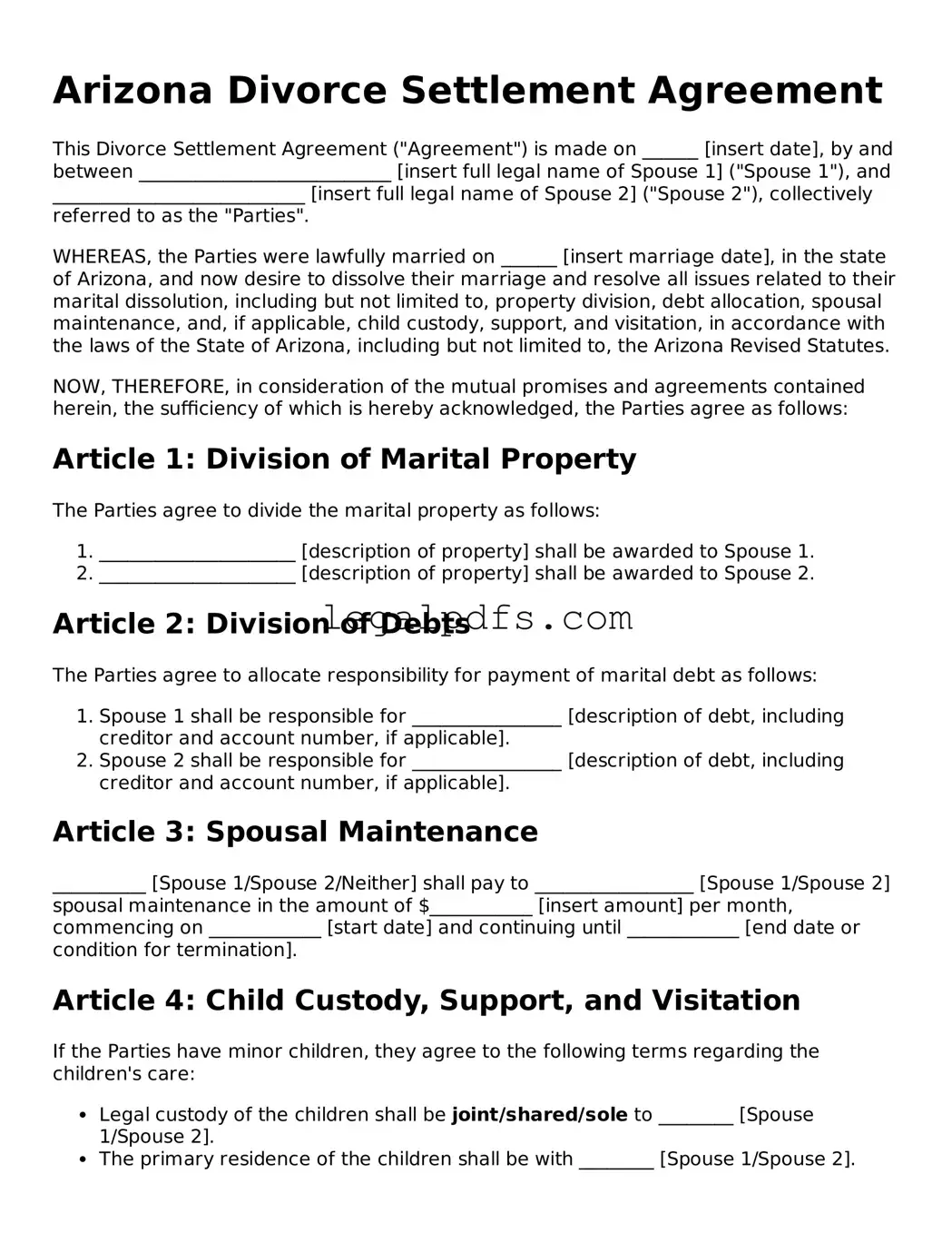Arizona Divorce Settlement Agreement
This Divorce Settlement Agreement ("Agreement") is made on ______ [insert date], by and between ___________________________ [insert full legal name of Spouse 1] ("Spouse 1"), and ___________________________ [insert full legal name of Spouse 2] ("Spouse 2"), collectively referred to as the "Parties".
WHEREAS, the Parties were lawfully married on ______ [insert marriage date], in the state of Arizona, and now desire to dissolve their marriage and resolve all issues related to their marital dissolution, including but not limited to, property division, debt allocation, spousal maintenance, and, if applicable, child custody, support, and visitation, in accordance with the laws of the State of Arizona, including but not limited to, the Arizona Revised Statutes.
NOW, THEREFORE, in consideration of the mutual promises and agreements contained herein, the sufficiency of which is hereby acknowledged, the Parties agree as follows:
Article 1: Division of Marital Property
The Parties agree to divide the marital property as follows:
- _____________________ [description of property] shall be awarded to Spouse 1.
- _____________________ [description of property] shall be awarded to Spouse 2.
Article 2: Division of Debts
The Parties agree to allocate responsibility for payment of marital debt as follows:
- Spouse 1 shall be responsible for ________________ [description of debt, including creditor and account number, if applicable].
- Spouse 2 shall be responsible for ________________ [description of debt, including creditor and account number, if applicable].
Article 3: Spousal Maintenance
__________ [Spouse 1/Spouse 2/Neither] shall pay to _________________ [Spouse 1/Spouse 2] spousal maintenance in the amount of $___________ [insert amount] per month, commencing on ____________ [start date] and continuing until ____________ [end date or condition for termination].
Article 4: Child Custody, Support, and Visitation
If the Parties have minor children, they agree to the following terms regarding the children's care:
- Legal custody of the children shall be joint/shared/sole to ________ [Spouse 1/Spouse 2].
- The primary residence of the children shall be with ________ [Spouse 1/Spouse 2].
- Child support shall be paid by ________ [Spouse 1/Spouse 2] in the amount of $___________ [insert amount] per month, commencing on ________ [start date] and continuing until each child reaches the age of 18 or graduates from high school, whichever is later.
- Visitation with the non-custodial parent shall be in accordance with the schedule attached hereto as Exhibit A.
Article 5: Miscellaneous
This Agreement shall be governed by and construed in accordance with the laws of the State of Arizona. Any disputes arising from this Agreement shall be resolved through mediation or, failing that, by the courts of Arizona.
The Parties hereby affirm that they have entered into this Agreement willingly and without duress, and have had the opportunity to seek independent legal counsel of their choice.
This Agreement represents the entire understanding between the Parties and supersedes all prior agreements, whether written or oral. Any amendments to this Agreement must be in writing and signed by both Parties.
IN WITNESS WHEREOF, the Parties have executed this Agreement as of the first date written above.
_____________________________________
Signature of Spouse 1
_____________________________________
Signature of Spouse 2
